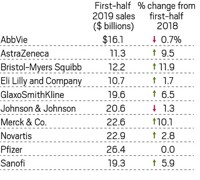Advertisement
Grab your lab coat. Let's get started
Welcome!
Welcome!
Create an account below to get 6 C&EN articles per month, receive newsletters and more - all free.
It seems this is your first time logging in online. Please enter the following information to continue.
As an ACS member you automatically get access to this site. All we need is few more details to create your reading experience.
Not you? Sign in with a different account.
Not you? Sign in with a different account.
ERROR 1
ERROR 1
ERROR 2
ERROR 2
ERROR 2
ERROR 2
ERROR 2
Password and Confirm password must match.
If you have an ACS member number, please enter it here so we can link this account to your membership. (optional)
ERROR 2
ACS values your privacy. By submitting your information, you are gaining access to C&EN and subscribing to our weekly newsletter. We use the information you provide to make your reading experience better, and we will never sell your data to third party members.
Business
Movers And Shakers
John C. Lechleiter
The Lilly CEO believes smart investment in R&D will help revive growth at the drug company
by Lisa M. Jarvis
February 25, 2013
| A version of this story appeared in
Volume 91, Issue 8
Eli Lilly & Co. is enduring one of the toughest periods of patent loss in the pharmaceutical industry at the same time that its new-drug pipeline is experiencing an unlucky string of failures. Despite the disappointments, John C. Lechleiter, the company’s chief executive officer, remains steadfast in his belief that investing in R&D is the best way to pull Lilly out of its slump. It’s not a strategy that all of his competitors share.
“The challenge that we face, the biggest challenge of our company in its 137-year history, has forced us to come to terms with who we are, what we do best, and how we’re going to write our future,” Lechleiter says.
In October 2011, the patent expired on Zyprexa, a schizophrenia drug that the previous year was the company’s top-selling product, with sales of $5.0 billion. The effect was immediate: In 2012, Zyprexa sales plummeted to $1.7 billion. Next year, Lilly will lose exclusivity on Cymbalta, an antidepressant that saw sales grow to $5.0 billion in 2012. In contrast, Lilly’s two next biggest products each bring in about half that amount.
The loss of these critical products came as no surprise, and Lilly has been working for years to build a pipeline of replacements. But the results have been abysmal: The number of Lilly drugs to fail in Phase III clinical studies in recent years far outweighs the number that reached the market.
With a perfect storm of problems, Lilly is not lacking for critics of its business strategy. Everyone from stock analysts to pharmaceutical consultants has an opinion about what the company should do to get back on track. Lechleiter says he listens to all the advice, but he also is quick to dispense with what he sees as quick fixes rather than long-term solutions.
One of the most common calls is for Lilly to make a grand gesture—a splashy acquisition that could immediately buttress the bottom line. “There have been suggestions we would have to merge and go through massive cost cutting and rationalization,” Lechleiter says. But his analysis of the megamergers of the past decade doesn’t support the claim that big acquisitions create long-term value for shareholders.
Another call is for Lilly to expand beyond its core strengths in pharmaceuticals and animal health, a tactic taken by many competitors. On that suggestion, Lechleiter is blunt. “We’re not going to diversify,” he says. “We know what we’re good at, and investors can diversify themselves by buying different stocks.”
Yet another call is for Lilly to spin off its lucrative animal health unit, a move Pfizer recently took to focus on pharmaceuticals. “We’re not going to do that,” Lechleiter says. “We understand how that business works and how it depends on the Lilly mother ship.” Lilly’s animal health business—the industry’s fourth largest and also the fastest growing—benefits from a research synergy with the human health business that would be lost if they were separated, he argues.
The final call is for major changes in Lilly’s approach to R&D. Many of Lilly’s competitors have cut research to the bone in a bid to save money. Pfizer, for example, chopped its R&D budget from $10.8 billion in 2008 to $7.9 billion in 2012.
Lilly, conversely, has steadily increased its budget. Last year, the firm spent $5.3 billion on R&D, roughly 6% more than in 2011, despite a 7% drop in sales. And although Lilly shed 5,500 workers in 2009, it has not, like many competitors, continued to bleed jobs annually.
When asked why Lilly departed from the standard industry script and increased R&D spending in the face of falling sales, Lechleiter puts it plainly: “Because we had to.” The pharmaceutical business, he says, is predicated on a company’s ability to develop new molecules, and that requires substantial investment in research.
And Lechleiter is convinced the investment will pay off. Between unprecedented knowledge about disease pathways and improved tools for measuring the impact of a drug, he says, “I don’t think there’s ever been a better time to invest in R&D in this industry.” Lechleiter has firsthand knowledge of the R&D process, having started his career at Lilly as a bench chemist.
Still, critics say Lilly has done a poor job of bringing new medicines to patients. Among the drugs that in recent years have failed to prove effective in Phase III studies are the Alzheimer’s disease drug semagacestat, the diabetes treatment teplizumab, the rheumatoid arthritis treatment tabalumab, and the schizophrenia drug pomaglumetad methionil.
Lechleiter argues that Lilly’s research skills are improving. In 2004, the firm had seven molecules in Phase II or III studies; today, that number is close to 35, with 13 compounds in Phase III. Moreover, 11 of those 13 molecules were discovered in Lilly’s own labs, rather than being licensed from a biotech firm. Lilly recently said it may ask regulators to approve up to five drugs this year.
“There are always going to be ups and downs” in drug discovery, Lechleiter acknowledges; that is the nature of the business. But he says he is “all about getting back to growth and ultimately putting the company in a position where our research output and growth are more sustainable.”





Join the conversation
Contact the reporter
Submit a Letter to the Editor for publication
Engage with us on Twitter